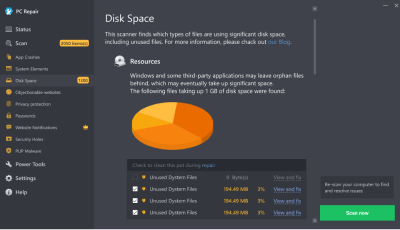How to fix and clean up system elements
The following steps may fix the issue:
- Step 1. Download Outbyte PC Repair application See more information about Outbyte uninstall instructions EULA Privacy Policy.
- Step 2.Install and launch the application
- Step 3.Click the Scan Now button to detect issues and abnormalities
- Step 4.Click the Repair All button to fix found issues
| Compatibility | Win 11, 10, 8, 7 |
| Download Size | 21.2 MB |
| Requirements | 300 MHz Processor, 256 MB RAM, 50 MB HDD |
Limitations: trial version offers an unlimited number of scans, backups and restores for free. Registration for the full version starts from USD 29.95.

Outbyte PC Repair (version 1.1.12.641) is certified by AppEsteem – a trusted cybersecurity organization – with ongoing monitoring.
Being able to meet all of AppEsteem’s strict requirements means that Outbyte PC Repair can be considered clean, safe, and transparent; and that it is compliant with the ethical and legal norms of distribution.
AppEsteem is one of the world’s most prominent cybersecurity organizations that contributes to the safety of more than 2 billion users. The company was founded by a team of experienced Microsoft cybersecurity specialists. Its mission is to create a safe space for computer and internet users where they are protected against cyber threats and deceptive or unethical practices.
The Windows system elements is a database that holds hundreds of thousands of crucial system settings and keys that are responsible for proper operation of software applications, various system components and the operating system itself. Over time, with software installs and uninstalls, as well as other PC activity, system elements may get filled with outdated or corrupt entries that may cause application or system malfunctions and lead to freezes and crashes.
An effective way to fix and clean up system elements is with the help of a special software that safely performs system elements cleanup and repair, and tunes up system settings.
The article provides details on the symptoms and causes of system elements issues and ways to fix and clean up system elements.
Contents
[hide]Ways to fix and clean up system elements
Advanced PC users may be able to fix and clean up the Windows system elements by manually editing or removing individual keys found to be corrupt or invalid. However, since any manipulations with the system elements carry a risk of rendering the operating system unbootable, whenever a user is in any doubt of their technical skills or knowledge, they may use a special software that is meant to repair the Windows system elements without requiring any special skills.
The following steps may fix and clean up system elements:
- Download Outbyte PC Repair
Special offer. See more information about Outbyte; uninstall instructions; EULA; Privacy Policy. - Install and launch the application
- Click the Scan Now button to detect issues and abnormalities
- Click the Repair All button to fix the issues and clean out invalid entries
The same application can be used to run preventative measures to reduce the chance of this or other system issues appearing in the future.
Symptoms of system elements issues
Among the most common symptoms of system elements issues are application or system freezes (when an application or the whole system stops responding to mouse clicks or any other user actions for a brief period of time, but later returns to normal operation), application or system crashes (when an application or the whole system stops responding to user actions and nothing can bring it back to normal operation; application has to be terminated or a PC reboot is required), random computer reboots that are not initiated by the user, various issues messages or BSOD ("blue screen of death" or the "STOP warning"), as well as connectivity issues that cannot be fixed by adjusting network settings. Issues with software uninstalls or reinstalls can also be a symptom of system elements issues.
Causes of system elements issues
System elements-related malfunctions are typically caused by invalid or corrupt system elements entries that get left over by various applications or appear due to software or system malfunctions, badly written application code or program incompatibilities. Whenever a PC is turned off in the middle of a Windows update being installed, an application task gets aborted midway or system files get moved on the hard drive, system elements issues may appear as a result. Other common reasons for system elements issues are virus or other malware activity, as well as incorrect software uninstalls, attempts by inexperienced users to manually edit system elements entries and a number of other factors.



